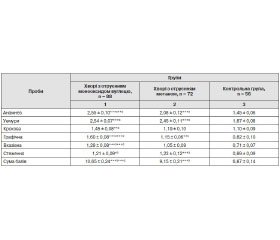Международный неврологический журнал 5 (75) 2015
Вернуться к номеру
The main autonomic-vestibular disorders with toxic and gypoxia encephalopathy due to acute poisoning by carbon monoxide and methane at the coal miners
Авторы: A.V. Igoshina, V.Yu. Nikolenko, G.V. Tyschchenko, O.Yu. Nikolenko - M.Gorky Donetsk national medical university, Ukraine
Рубрики: Неврология
Разделы: Справочник специалиста
Версия для печати
The problem of high mortality at the coal miners due the underground release of methane as for society and the system health of Ukraine is actual. The acute carbon monoxide poisoning of the coal mines are the most frequent types of intoxications. The development of the hypoxic hypoxia is the main mechanism of methane’s poisoning. The brain and the vestibular analyzer are the very sensitive organs to oxygen deficiency. The hypoxic encephalopathy, autonomic-vascular dystonia and vestibulopathy are the result of the beginning changes in Central nervous system. The mechanism of action in central nervous system of carbon monoxide is consisting in hypoxemia and direct action on the enzyme systems of the nervous tissue. The toxic and hypoxic encephalopathy is develops as a result of carbon monoxide poisoning. Important medical and socio-economic task is the recovering of the physical and social-economic health of illness coal miners.
Materials and methods
88 coal miners with acute carbon monoxide poisoning were examined in neurological clinic. Their ages was from 21 to 72 years old, the average age was (40,8±1,1) years old. Their the underground experience was from 1,0 to 45 years, on average (14,1±0,8) years (S=1,68, p=0,09, MW=1,47, p=0,14 та S=0,89, p=0,37, MW=0,61, p=0,54 accordingly). And 72 coal miners with acute methane poisoning were examined too. Their ages was from 20 to 54 years old, the average age was (39,01±0,8) years. Their the underground experience was from 1,0 to 28 years, on average (12,8±0,8) years (S=0,75, p=0,45, MW=0,72, p=0,46 та S=0,10, p=0,92, MW=0,26, p=0,78 accordingly). Both of groups with acute carbon monoxide and methane poisoning were not significantly different in age and experience (S=1,03, p=0,30, MW=1,04, p=0,29 and S=0,88, p=0,37, MW=0,97, p=0,32 accordingly).
The control group was consisted 56 healthy coal miners, which did not differ for ages, experience and conditions of work. The average age of control group was (37,9±1,2) years, the underground experience was from 2 to 25 years, on average (12,9±0,9) years. The average age the persons of control group was (37,9±1,2) years, their the underground experience was from 2 to 25 years, on average (12,9±0,9) years.
The result of Aschner-Dagnini test determined the autonomic reactivity for illness coal miners. The orthostatic sample determined autonomic security activities. The 20 point score express diagnosis of K.F. Trinus determined the condition of the vestibular analyzer. The results of analysis are based on the principles of evidence-based medicine.
Results and discussion
The result of Aschner-Dagnini test in the coal miners with acute carbon monoxide poisoning relative to the control in the first place identified simpaticotonics reply: (71,60±4,80) % cases to (17,86±5,11) % cases (c2=14,52, p=0,0001), then normotone: (22,72±4,46) % cases to (75,0±5,78) % cases (c2=14,47, p=0,0001) and rarely met parasympathicotonics, which did not differ from the control: (5,68±2,46) % to (7,14±3,44) % cases (c2=0,11, p=0,7405). The results of the sample in the coal miners with acute poisoning of methane differed from the control such as: most often met simpaticotonics reply too and consist (80,6±4,7) % cases in illness patient (c2=16,77, p<0,001), less – normotonics (13,8±4,07) % in illness cases (c2=20,43, p<0,001), which differ from the control and parasympathicotonics is consist (5,6±2,7) % cases, which did not differ from the control (c2=0,12, p=0,7298).
In the performance of orthostatic sample in coal miners with acute methane poisoning was moderate acceleration pulse on average on the (18,56±0,89) BPM in contrast of control group, which consist (11,85±0,58) BPM (MW=5,72, p<0,001; S=5,77, p<0,001). The acceleration of pulse of carbon monoxide poisoning on average consist (15,10±1,07) BPM in contrast of control group, which consist (11,85±0,58) BPM (MW=2,55, p=0,01; S=2,20, p=0,029).
The vestibular analyzer lesions in patients with carbon monoxide poisoning was manifested in vestibulomotor projection (graphic sample-1,95) violation of higher associative functions (index test – 1,82) and vestibular projection (complaints of dizziness – 1,76). In patients with methane poisoning, where lesions were less pronounced, a first place had to violations of higher associative functions (index test – 1,48), vestibular (complaints of dizziness – 1,43) and then vestibulomotor changes (graphic sample-1,40).
Conclusions
It is established that patients miners with toxicohypoxic and hypoxic encephalopathy are unprofitable autonomic management due to the dominance sympathicotonics responses (71,60±4,80) % and (80,6±4,7) % sample results Aschnera-Dagnini test. The definition of autonomic maintenance activities using the orthostatic test revealed a moderate acceleration of the pulse in both arms patients on average (18,56±0,89) BPM, in cases of acute poisoning methane and (of 15.10±1,07) BPM, in cases of acute carbon monoxide poisoning. The definition of clinical in patient with acute carbon monoxide and methane poisoning in the study of vestibular disorders was very important, because their offense could lead to breakdowns compensatory reactions in the future.

